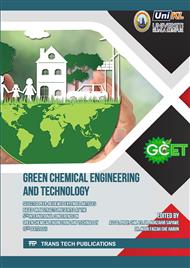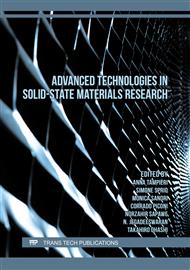p.11
p.19
p.29
p.35
p.53
p.61
p.69
p.79
p.89
A Study of Thermal Stability and Degradation Kinetics of Microcrystalline Cellulose (MCC)/Sol-Gel Silica (SiO2) Hybrid Materials
Abstract:
Microcrystalline cellulose (MCC) has been widely used in the production of composite materials because it is inexpensive, easy to process, good mechanical properties and environmentally friendly. Despite its advantages, MCC has disadvantages such as poor thermal stability, hygroscopic and poor compatibility with hydrophobic materials. Understanding the thermal behavior of MCC is important because thermal degradation occurs at different rates and directly affects the final product. In this study, the MCC/ SiO2 hybrid materials were prepared using in-situ sol-gel synthesis, followed by the investigation of their thermal stability and degradation kinetics using thermogravimetric analysis (TGA). Degradation kinetics were analysed using two model-free analysis (i.e. Flynn-Wall-Ozawa, FWO and modified Coats-Redfern, CRm) to evaluate the degradation behaviour (conversion degree (α) of 0.1 to 0.8) and activation energies (Ea) of MCC, MCC/ sol-gel silica (MCC/SiO2) and modified MCC (mMCC/SiO2) at heating rates (β) of 10, 20, 30 and 40 °C/min. Thermal stability results showed that the presence of silica on MCC had no influence on the degradation temperature of the hybrid material however, it slightly shifted the Tonset to higher values. The presence of silica also increased the final residue of the hybrid, especially in mMCC/SiO2 samples. DTG curves clearly show that all samples exhibited one step degradation process. The kinetics study assumed that all samples has single reaction mechanism as the fitted line was parallel in almost all conversion degrees (α) in both FWO and CRm methods. Ea calculated for MCC, MCC/SiO2 and mMCC/SiO2 are in good fit with both FWO and CRm model where the R2 observed more than 0.97. Ea was increased in both methods, MCC/SiO2 and mMCC/SiO2 as compared to MCC, which implied that the addition of sol-gel silica to MCC could promote a stepwise degradation.
Info:
Periodical:
Pages:
53-59
Citation:
Online since:
December 2022
Price:
Сopyright:
© 2022 Trans Tech Publications Ltd. All Rights Reserved
Share:
Citation:



